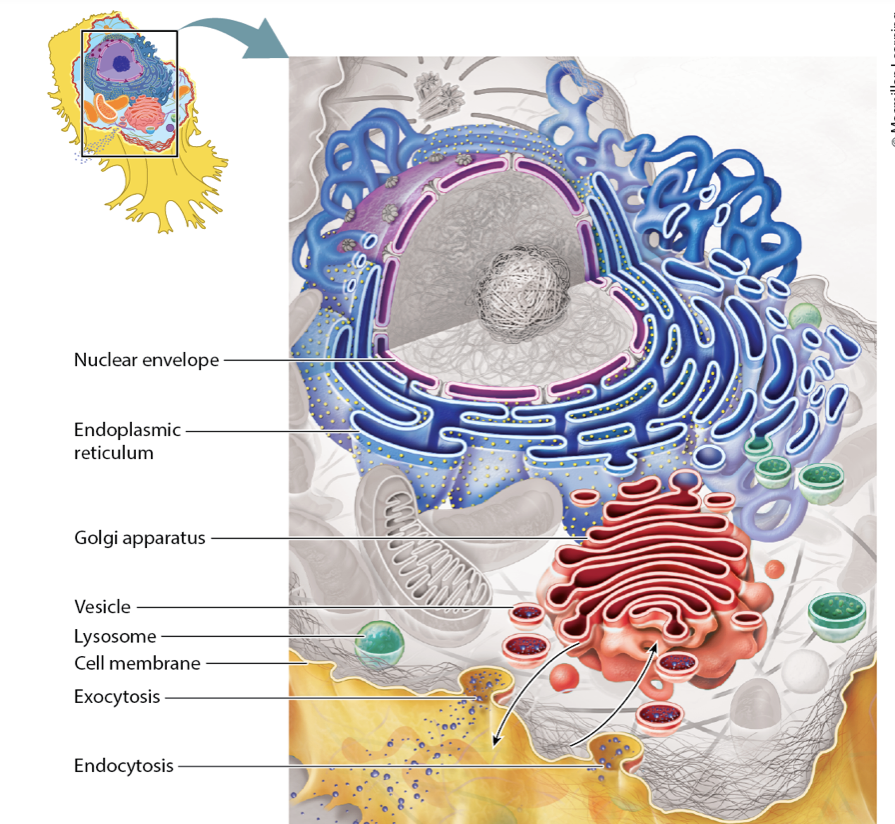Topic 9: The Endomembrane System
1/20
There's no tags or description
Looks like no tags are added yet.
Name | Mastery | Learn | Test | Matching | Spaced |
|---|
No study sessions yet.
21 Terms
What is the endomembrane system?
A group of interconnected membrane-bound organelles within a eukaryotic cell that work together to modify, package, and transport proteins and lipids

Nucleus
• Contains DNA
• Replication
• Transcription
• Pores for small molecules and ions
• Large molecules cross through
active transport
• Double membraned (nuclear
envelope)
What needs to pass across the nuclear membrane?
Proteins like transcription factors, DNA polymerases, RNA polymerases, and other regulatory molecules which are necessary for gene expression, as well as mRNA molecules that need to exit the nucleus to reach the ribosomes for protein synthesis
Endoplasmic Reticulum
ER membrane is continuous with the outer nuclear envelope.
Rough ER
• associated with ribosomes
• site of translation of proteins that embedded in the membrane or secreted
Smooth ER
• no ribosomes
• site of lipid synthesis
Ribosomes
1. Bound to ER
Proteins to be secreted or embedded within the plasma membrane
2. Free in Cytoplasm
Cytoplasmic proteins and proteins that are important in other organelles (mitochondria, chloroplasts, peroxisomes, nucleus)
Golgi Apparatus
• Proteins and lipids created in ER often travel to Golgi Apparatus in vesicles
• Proteins and lipids modified as they pass from one cistern to another
Cistern
A fluid-filled sac or cavity that stores water or bodily fluids
Lysosomes
• Lumen (interior) very acidic
• Enzymes break down macromolecules
Why would you ever need to break down
macromolecules? Why have a acidic lumen?
Breaking down macromolecules is necessary because large, complex molecules like proteins, carbohydrates, and lipids cannot be directly absorbed by cells; they need to be broken down into smaller subunits (monomers) like amino acids, glucose, and fatty acids to be utilized by the body, and an acidic lumen provides the optimal environment for the digestive enzymes that facilitate this breakdown process.
Describe the structure of the endomembrane system in eukaryotic cells and summarize the functions of the different parts
The endomembrane system is an interconnected system of membranes that defines spaces in the cell, synthesizes important molecules, and traffics and sorts these molecules in and out of the cell.
• The endomembrane system includes the nuclear envelope, endoplasmic reticulum, Golgi apparatus, lysosomes, vesicles, and plasma membrane.
• The nucleus, which is enclosed by a double membrane called the nuclear envelope, houses the genome.
Relate the different parts of the endoplasmic reticulum to their roles in the manufacture of proteins and lipids.
The endoplasmic reticulum is continuous with the outer nuclear envelope and manufactures proteins and lipids for use by the cell or for export out of the cell.
Explain the roles of the nuclear envelope in regulating which molecules move in and out of the nucleus.
The nuclear envelope regulates which molecules move in and out of the nucleus by having embedded "nuclear pores" which act as selective channels, allowing only specific molecules to pass through based on their size and recognition signals
Describe the role of the Golgi apparatus in introducing chemical modifications to proteins and directing them to their final cellular or extracellular location.
The Golgi apparatus communicates with the endoplasmic reticulum by transport vesicles. It receives proteins and lipids from the endoplasmic reticulum and directs them to their final destinations
Describe the role of lysosomes in recycling cellular components
Lysosomes break down macromolecules such as proteins into simpler compounds that can be used by the cell.
How do the rough endoplasmic reticulum and smooth endoplasmic reticulum differ in terms of structure and function?
Rough endoplasmic reticulum have ribosomes associated with the membrane. It is the site of translation of proteins that are embedded in the membrane or secreted
Smooth endoplasmic reticulum has no ribosomes and is the site of lipid synthesis
Describe the structure of the nuclear envelope.
The nuclear envelope is a double membrane with spaces known as nuclear pores.
Describe the structure and function of the Golgi apparatus.
Golgi structure is a series of separate cisternae. (drawings should be accepted)
Golgi functions by modifying proteins and lipids as they pass from one cistern to another
Name the two parts of the endoplasmic reticulum and explain how they differ in structure and function.
Rough endoplasmic reticulum:
Structure: has ribosomes on the membrane
Function: site of protein synthesis/translation/production
Smooth endoplasmic reticulum:
Structure: no ribosomes on the membrane
Function: site of lipid synthesis/production
How do lysosomes illustrate the importance of compartmentalizing certain reactions in different spaces in the cell?
Lysosomes function to break down macromolecules. It is important that these reactions are confined to the lysosome otherwise necessary molecules would be broken down accidentally.